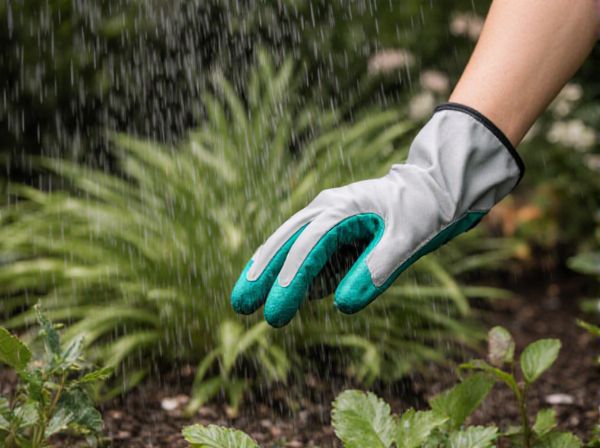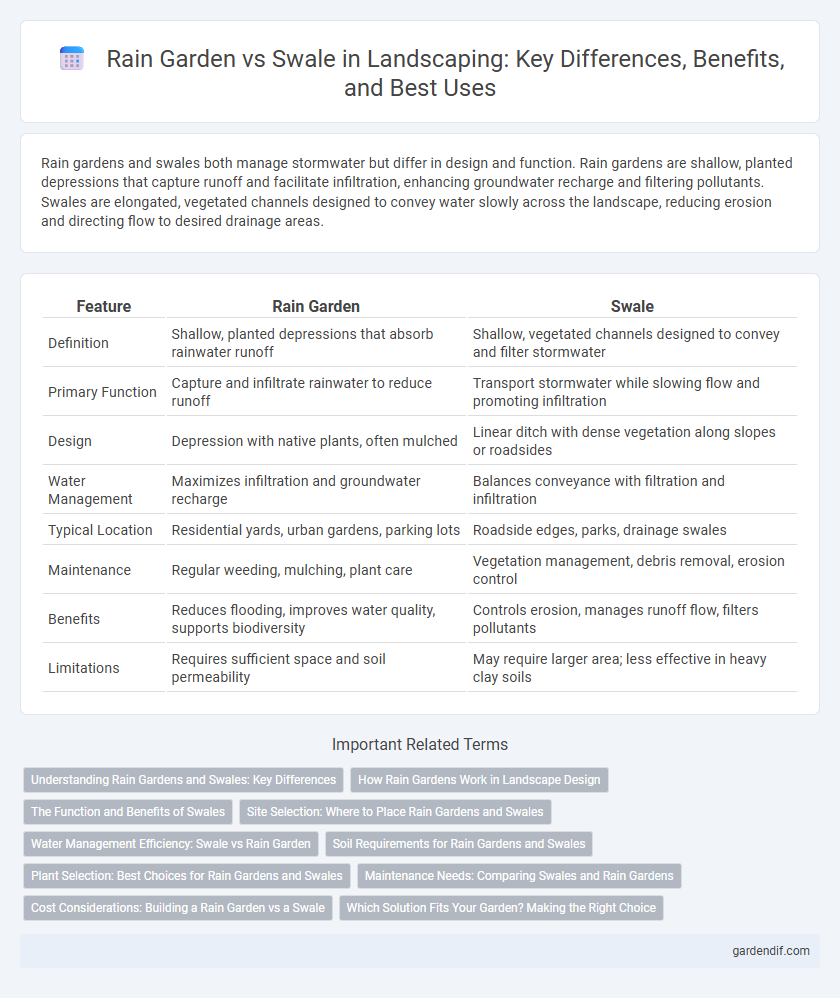
Rain Garden vs Swale Illustration
Rain gardens and swales both manage stormwater but differ in design and function. Rain gardens are shallow, planted depressions that capture runoff and facilitate infiltration, enhancing groundwater recharge and filtering pollutants. Swales are elongated, vegetated channels designed to convey water slowly across the landscape, reducing erosion and directing flow to desired drainage areas.
Table of Comparison
| Feature | Rain Garden | Swale |
|---|---|---|
| Definition | Shallow, planted depressions that absorb rainwater runoff | Shallow, vegetated channels designed to convey and filter stormwater |
| Primary Function | Capture and infiltrate rainwater to reduce runoff | Transport stormwater while slowing flow and promoting infiltration |
| Design | Depression with native plants, often mulched | Linear ditch with dense vegetation along slopes or roadsides |
| Water Management | Maximizes infiltration and groundwater recharge | Balances conveyance with filtration and infiltration |
| Typical Location | Residential yards, urban gardens, parking lots | Roadside edges, parks, drainage swales |
| Maintenance | Regular weeding, mulching, plant care | Vegetation management, debris removal, erosion control |
| Benefits | Reduces flooding, improves water quality, supports biodiversity | Controls erosion, manages runoff flow, filters pollutants |
| Limitations | Requires sufficient space and soil permeability | May require larger area; less effective in heavy clay soils |
Understanding Rain Gardens and Swales: Key Differences
Rain gardens are shallow, planted depressions designed to capture and infiltrate rainwater, promoting groundwater recharge and reducing runoff, while swales are linear, vegetated channels that convey stormwater, slowing flow to reduce erosion and filter pollutants. Rain gardens focus on retention and infiltration at specific points, often in residential or urban landscapes, whereas swales manage and direct water along a broader landscape slope, commonly used in green infrastructure and roadside settings. Both systems enhance stormwater management but differ in form, function, and placement within sustainable landscape design.
How Rain Gardens Work in Landscape Design
Rain gardens capture and absorb stormwater runoff, using native plants and engineered soil layers to filter pollutants and prevent erosion in landscape design. By directing water into a shallow depression, they promote water infiltration and recharge groundwater, reducing pressure on drainage systems. This sustainable approach enhances biodiversity while managing runoff effectively within residential or urban landscapes.
The Function and Benefits of Swales
Swales function as shallow, vegetated channels designed to manage stormwater runoff by slowing, filtering, and directing it away from critical areas, reducing erosion and improving water quality. They enhance groundwater recharge while supporting diverse plant habitats that stabilize soil and capture pollutants. Swales are particularly effective in urban and suburban landscapes for mitigating flooding and promoting sustainable water management.
Site Selection: Where to Place Rain Gardens and Swales
Rain gardens are best placed in low-lying areas near downspouts or natural drainage paths where water naturally collects, ensuring effective stormwater absorption and filtration. Swales are ideal along slopes or contour lines to slow runoff, direct flow, and promote groundwater recharge without causing erosion. Site selection must consider soil permeability, existing vegetation, and proximity to structures to optimize water management and landscape health.
Water Management Efficiency: Swale vs Rain Garden
Swales provide efficient water management by directing and slowing stormwater runoff through gently sloped channels, allowing infiltration and reducing erosion. Rain gardens enhance water retention by capturing runoff in a planted basin, promoting groundwater recharge and filtering pollutants. Swales excel in managing large volumes of water across extensive areas, while rain gardens offer targeted treatment and infiltration in localized settings.
Soil Requirements for Rain Gardens and Swales
Rain gardens require well-draining, loamy soil with a mix of sand, silt, and organic matter to promote infiltration and support diverse plant roots, while swales function effectively in a wider range of soils but prefer moderately permeable soils to facilitate slow water conveyance and filtration. Rain garden soil must allow quick absorption to prevent standing water, typically involving amended topsoil or engineered soil mixes, whereas swales rely on natural soil profile for gradual groundwater recharge and erosion control. Proper soil composition directly influences the hydrological performance and vegetation health in both rain gardens and swales, making soil testing and amendment essential during design and installation.
Plant Selection: Best Choices for Rain Gardens and Swales
Rain gardens thrive with native plants like purple coneflower, swamp milkweed, and blue flag iris that tolerate periodic flooding and dry spells, enhancing water absorption and soil stabilization. Swales benefit from deep-rooted grasses such as switchgrass, big bluestem, and sedges, which effectively slow water flow, reduce erosion, and improve infiltration. Selecting species adapted to local climate and soil conditions ensures optimal performance and sustainability of rain gardens and swales in stormwater management.
Maintenance Needs: Comparing Swales and Rain Gardens
Swales require regular inspection to prevent sediment buildup and ensure proper water flow, often needing periodic mowing and debris removal. Rain gardens demand maintenance of soil health by monitoring plant growth, removing invasive species, and replenishing mulch to sustain water absorption and filtration. Both landscape features benefit from seasonal upkeep, but rain gardens generally necessitate more attentive plant care while swales focus on maintaining structural integrity.
Cost Considerations: Building a Rain Garden vs a Swale
Rain gardens generally require higher initial investment due to excavation, specialized soil amendments, and native plant installation, whereas swales tend to be more cost-effective by utilizing natural land contours for water runoff management. Maintenance costs for rain gardens can be higher because of plant care and periodic soil replacement, while swales typically need occasional cleaning and mowing to maintain functionality. Factoring in local soil conditions and drainage needs is essential for accurate budgeting between these two stormwater management solutions.
Which Solution Fits Your Garden? Making the Right Choice
Rain gardens effectively capture and filter stormwater using native plants and engineered soil, ideal for smaller areas with moderate drainage needs. Swales manage larger volumes of water by directing runoff through shallow, vegetated channels, making them suitable for sloped landscapes or expansive yards. Assess site topography, soil type, and drainage capacity to determine whether a rain garden's absorption or a swale's conveyance best fits your garden's stormwater management goals.
Rain Garden vs Swale Infographic

 gardendif.com
gardendif.com